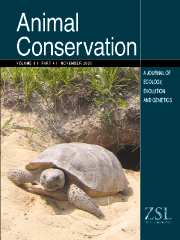Article contents
Developing recovery and monitoring strategies for the endemic Mount Graham red squirrels (Tamiasciurus hudsonicus grahamensis) in Arizona
Published online by Cambridge University Press: 02 February 2004
Abstract
An important challenge in conservation biology is extracting pertinent information from the available data for endangered species. Rarely do we have enough information to precisely determine an organism's risk of extinction and other factors that affect its management. How, then, can we use limited information to make responsible conservation decisions on controversial species such as the Mount Graham red squirrel? We used several analytical approaches to examine 15 years of abundance data for the Mount Graham red squirrel in order to propose recovery criteria and to evaluate alternative conservation strategies. We analysed the historical population dynamics using a diffusion approximation model and showed that the main threat to the population was not the overall growth rate (which may well be greater than 1) but rather the wide range of variation in annual growth rates. We used information on the distribution of growth rates and abundance to classify the species as threatened under the Endangered Species Act (ESA). We then presented a simple demographic model to examine the effects of proportional changes in vital rates on the population growth rate (λ). The elasticity values obtained for Mount Graham red squirrels indicate that the population is far more sensitive to changes in survival rates (particularly adult survival) compared to reproduction. Our analyses suggest that management should focus on refining monitoring techniques, reducing sources of variability, improving the survival of adult animals and filling the gaps in the currently available data.
- Type
- Research Article
- Information
- Copyright
- 2004 The Zoological Society of London
- 17
- Cited by


